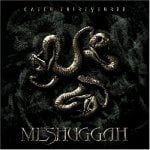
Meshuggah have never been one to shy away from confounding listeners. After turning the metal world on its ear with the groundbreaking 1995 album Destroy Erase Improve, every release since has gotten more and more experimental, the band redefining post-thrash metal with mechanical riffs, mathematically complex time signatures, and jazz-infused soloing. It’s been a decade-long run that none of their peers have been able to match during the same period of time, and the past three years especially have marked a career high for the Swedish band. 2002’s Nothing was a complete 180 degree change in direction from the speed-fueled intensity of 1998’s Chaosphere four years earlier, as the music was slowed down to an extremely disciplined crawl, allowing guitarist Marten Hagstrom and Frederik Thorendal to draw every ounce of sustained noted out of their downtuned, custom-made eight-string guitars. Released in late 2004, the single-track I EP was arguably Meshuggah’s best piece of work to date, a culmination of everything the band had done the previous decade, as the thrilling 21-minute composition drew from each of the band’s incarnations, seamlessly incorporating slow with chaotic.
Continuing right where I left off, Meshuggah promised their fifth full length album would also be a continuous, single-track effort, but unlike the crazed ambition of the epic suite Frances the Mute, by The Mars Volta, Meshuggah have thrown their fans for a loop yet again, casting aside the complexity of “I”, in favor of a very cold, precise exercise in
Oddly enough, that lack of emotion is exactly what the band set out to achieve, so they deserve credit, as the first 15 minutes is progressive metal at its chilliest. A straightforward, grim, midtempo jam, the first third of Catch Thirtythree centers around two simple riffs, the first one working more rhythmically than melodically, and a second considerably more elastic sounding, as vocalist Jens Kidman barks out more of the same enigmatic lyrics they always write (“The scattered jigsaw of my redemption laid out before my eyes/ Each piece as amorphous as the other”). It’s an extremely underwhelming way to open an album, and in a genre that relies greatly on aggression, such restraint will have many listeners up in arms.
Mercifully, the album manages to shift out of autopilot for the last half hour. After the interlude “Mind’s Mirrors”, things kick into high gear (no, make that second gear) during the section “In Death – Is Life”, as Thorendal and Hagstrom launch into the kind of huge-sounding riffs that they do so well. As the band segues into the beastly “In Death – Is Death”, they come closest to sounding like the Meshuggah we all know and love, matching the more inspired, intense moments from Nothing, the lithe chords bending and churning, as Thorendal launches into his trademark, free jazz-inspired soloing. The jazz influence comes to a head midway through the track, as the bent notes of a downtuned guitar imitates a fretless bass, which dissolves into an extended breakdown of backwards notes and atonal chiming, before erupting into the fantastic, menacing climax of “Shed”, “Personae Non Gratae”, and “Dehumanization”.
Despite the steady, middle of the road pace of the album, an air of spontaneity is detectable. Pieced together arbitrarily over an eight-month writing and recording period, the band does not intend to performCatch Thirtythree live, and is merely an experiment in Pro Tools editing. Most surprisingly, drummer Tomas Haake, one of the most talented percussionists in metal today, is conspicuously absent on the new record. Aside from a spoken word narration on “Mind’s Mirrors”, he doesn’t perform at all, leaving the percussion work to programmed drums instead, the constant addition of complicated riffs apparently making it impossible for him to keep up with Thorendal and Hagstrom. While the programmed drums actually fit well with the artificiality of the album’s sound, Haake’s flair on drums is sorely missed.
Although it has its moments, Catch Thirtythree is ultimately a slight misfire by one of the world’s most exciting bands. Still, because Meshuggah are a band brimming with talent and ambition, even a flawed, self-indulgent experiment like this album is still better than much of the metal that’s out there these days. It’s an admirable attempt at trying something new, but we’ll all be happier with a more organic sounding album the next time around.

![Call for Papers: All Things Reconsidered [MUSIC] May-August 2024](https://www.popmatters.com/wp-content/uploads/2024/04/all-things-reconsidered-call-music-may-2024-720x380.jpg)



